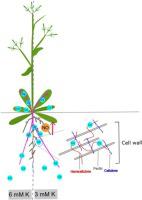当前位置:
X-MOL 学术
›
Environ. Exp. Bot.
›
论文详情
Our official English website, www.x-mol.net, welcomes your
feedback! (Note: you will need to create a separate account there.)
Potassium affects cadmium resistance in Arabidopsis through facilitating root cell wall Cd retention in a nitric oxide dependent manner
Environmental and Experimental Botany ( IF 4.5 ) Pub Date : 2020-10-01 , DOI: 10.1016/j.envexpbot.2020.104175 Qi Wu , Xiaofang Zhu , Xusheng Zhao , Renfang Shen
Environmental and Experimental Botany ( IF 4.5 ) Pub Date : 2020-10-01 , DOI: 10.1016/j.envexpbot.2020.104175 Qi Wu , Xiaofang Zhu , Xusheng Zhao , Renfang Shen

|
Abstract Potassium (K) plays an important role in plant development and in plant responses to various environmental stresses; however, its involvement in the mitigation of heavy metal stress by altering the binding capacity of the cell wall in Arabidopsis thaliana remains elusive. Here, we examined the effect of K (0–12 mM) in the regulation of cadmium (Cd) resistance in Arabidopsis thaliana. Toxic levels of Cd (50 μM) cause chlorosis in young leaves; however, the application of 3 mM K significantly alleviated this symptom in Arabidopsis thaliana, while other K concentrations did not rescue this phenotype. Moreover, 3 mM K significantly increased cell wall polysaccharide (hemicellulose) content and Cd adsorption in the root cell walls, suggesting that the modification of the cell wall composition is responsible for the Cd retention in the root under 3 mM K application. The 3 mM K treatment significantly reduced the expression of genes related to Cd uptake when plants were exposed to Cd, implying a decrease in Cd entering the cells. Furthermore, endogenous Nitric oxide (NO) was demonstrated to be involved in 3 mM K ameliorated-Cd toxicity as nia1nia2 and noa1 mutants, which are defective in NO biosynthesis, this positive effect of 3 mM K on Cd toxicity was abolished. Taken together, our results indicated that the 3 mM K alleviated deleterious effects of Cd by modifying the cell wall Cd binding capacity, particularly through the regulation of the NO accumulation in Arabidopsis thaliana.
中文翻译:

钾通过以一氧化氮依赖性方式促进根细胞壁 Cd 保留来影响拟南芥中的镉抗性
摘要 钾 (K) 在植物发育和植物对各种环境胁迫的响应中起着重要作用。然而,它通过改变拟南芥细胞壁的结合能力来减轻重金属压力的作用仍然难以捉摸。在这里,我们检查了 K (0-12 mM) 在调节拟南芥中镉 (Cd) 抗性中的作用。有毒水平的 Cd (50 μM) 会导致幼叶萎黄;然而,在拟南芥中,3 mM K 的应用显着缓解了这种症状,而其他 K 浓度并没有挽救这种表型。此外,3 mM K 显着增加细胞壁多糖(半纤维素)含量和根细胞壁对 Cd 的吸附,这表明细胞壁组成的改变是在 3 mM K 应用下根中 Cd 保留的原因。当植物暴露于 Cd 时,3 mM K 处理显着降低了与 Cd 吸收相关的基因的表达,这意味着进入细胞的 Cd 减少。此外,内源性一氧化氮 (NO) 被证明参与 3 mM K 改善 Cd 毒性,因为 nia1nia2 和 noa1 突变体在 NO 生物合成中存在缺陷,3 mM K 对 Cd 毒性的这种积极影响被取消。总之,我们的结果表明,3 mM K 通过改变细胞壁 Cd 结合能力,特别是通过调节拟南芥中 NO 的积累,减轻了 Cd 的有害影响。当植物暴露于 Cd 时,3 mM K 处理显着降低了与 Cd 吸收相关的基因的表达,这意味着进入细胞的 Cd 减少。此外,内源性一氧化氮 (NO) 被证明参与 3 mM K 改善 Cd 毒性,因为 nia1nia2 和 noa1 突变体在 NO 生物合成中存在缺陷,3 mM K 对 Cd 毒性的这种积极影响被取消。总之,我们的结果表明,3 mM K 通过改变细胞壁 Cd 结合能力,特别是通过调节拟南芥中 NO 的积累,减轻了 Cd 的有害影响。当植物暴露于 Cd 时,3 mM K 处理显着降低了与 Cd 吸收相关的基因的表达,这意味着进入细胞的 Cd 减少。此外,内源性一氧化氮 (NO) 被证明参与 3 mM K 改善 Cd 毒性,因为 nia1nia2 和 noa1 突变体在 NO 生物合成中存在缺陷,3 mM K 对 Cd 毒性的这种积极影响被取消。总之,我们的结果表明,3 mM K 通过改变细胞壁 Cd 结合能力,特别是通过调节拟南芥中 NO 的积累,减轻了 Cd 的有害影响。NO 生物合成有缺陷,3 mM K 对 Cd 毒性的这种积极影响被取消。总之,我们的结果表明,3 mM K 通过改变细胞壁 Cd 结合能力,特别是通过调节拟南芥中 NO 的积累,减轻了 Cd 的有害影响。NO 生物合成有缺陷,3 mM K 对 Cd 毒性的这种积极影响被取消。总之,我们的结果表明,3 mM K 通过改变细胞壁 Cd 结合能力,特别是通过调节拟南芥中 NO 的积累,减轻了 Cd 的有害影响。
更新日期:2020-10-01
中文翻译:

钾通过以一氧化氮依赖性方式促进根细胞壁 Cd 保留来影响拟南芥中的镉抗性
摘要 钾 (K) 在植物发育和植物对各种环境胁迫的响应中起着重要作用。然而,它通过改变拟南芥细胞壁的结合能力来减轻重金属压力的作用仍然难以捉摸。在这里,我们检查了 K (0-12 mM) 在调节拟南芥中镉 (Cd) 抗性中的作用。有毒水平的 Cd (50 μM) 会导致幼叶萎黄;然而,在拟南芥中,3 mM K 的应用显着缓解了这种症状,而其他 K 浓度并没有挽救这种表型。此外,3 mM K 显着增加细胞壁多糖(半纤维素)含量和根细胞壁对 Cd 的吸附,这表明细胞壁组成的改变是在 3 mM K 应用下根中 Cd 保留的原因。当植物暴露于 Cd 时,3 mM K 处理显着降低了与 Cd 吸收相关的基因的表达,这意味着进入细胞的 Cd 减少。此外,内源性一氧化氮 (NO) 被证明参与 3 mM K 改善 Cd 毒性,因为 nia1nia2 和 noa1 突变体在 NO 生物合成中存在缺陷,3 mM K 对 Cd 毒性的这种积极影响被取消。总之,我们的结果表明,3 mM K 通过改变细胞壁 Cd 结合能力,特别是通过调节拟南芥中 NO 的积累,减轻了 Cd 的有害影响。当植物暴露于 Cd 时,3 mM K 处理显着降低了与 Cd 吸收相关的基因的表达,这意味着进入细胞的 Cd 减少。此外,内源性一氧化氮 (NO) 被证明参与 3 mM K 改善 Cd 毒性,因为 nia1nia2 和 noa1 突变体在 NO 生物合成中存在缺陷,3 mM K 对 Cd 毒性的这种积极影响被取消。总之,我们的结果表明,3 mM K 通过改变细胞壁 Cd 结合能力,特别是通过调节拟南芥中 NO 的积累,减轻了 Cd 的有害影响。当植物暴露于 Cd 时,3 mM K 处理显着降低了与 Cd 吸收相关的基因的表达,这意味着进入细胞的 Cd 减少。此外,内源性一氧化氮 (NO) 被证明参与 3 mM K 改善 Cd 毒性,因为 nia1nia2 和 noa1 突变体在 NO 生物合成中存在缺陷,3 mM K 对 Cd 毒性的这种积极影响被取消。总之,我们的结果表明,3 mM K 通过改变细胞壁 Cd 结合能力,特别是通过调节拟南芥中 NO 的积累,减轻了 Cd 的有害影响。NO 生物合成有缺陷,3 mM K 对 Cd 毒性的这种积极影响被取消。总之,我们的结果表明,3 mM K 通过改变细胞壁 Cd 结合能力,特别是通过调节拟南芥中 NO 的积累,减轻了 Cd 的有害影响。NO 生物合成有缺陷,3 mM K 对 Cd 毒性的这种积极影响被取消。总之,我们的结果表明,3 mM K 通过改变细胞壁 Cd 结合能力,特别是通过调节拟南芥中 NO 的积累,减轻了 Cd 的有害影响。











































 京公网安备 11010802027423号
京公网安备 11010802027423号